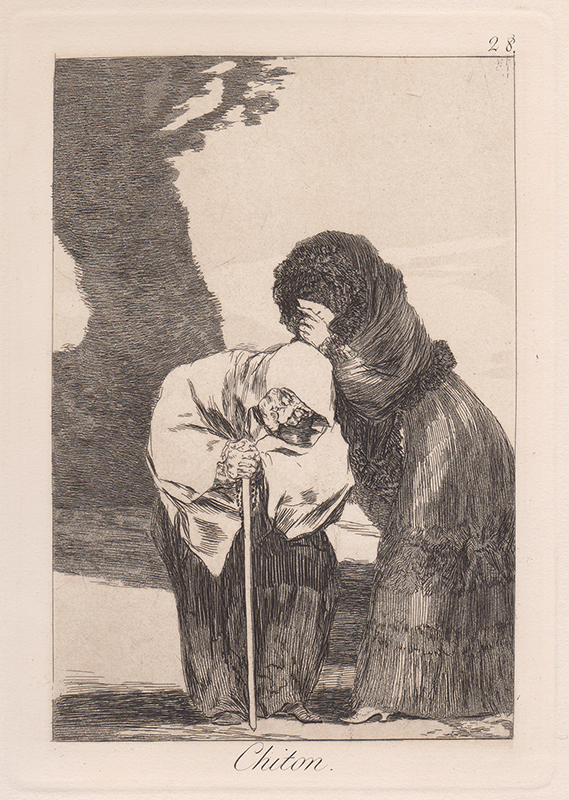
19th, 20th & 21st Century Fine Prints
707-546-7352 · fax 707-546-7924 · web: www.annexgalleries.com · email: artannex@aol.com
Chiton ('Hush', plate 28 from the series Los Caprichos) by Francisco Goya

Chiton ('Hush', plate 28 from the series Los Caprichos)
Francisco Goya
Chiton ('Hush', plate 28 from the series Los Caprichos)
Francisco Goya
1746 - 1828 (biography)In Spanish 'Chiton' is the generic word for mussels (oysters, clams, etc.), and it is used, generally, with an exclamation mark, to mean 'Not a word' or 'Hush'. Goya's comment about this image reads: "An excellent mother to trust with a confidential commission". There is a crayon drawing for this image in the Prado.
This is plate 28 of 'Los Caprichos', a series of 80 etchings and aquatints that Goya created in 1797 and 1798 and were printed after his death in twelve editions between 1799 and 1937. Impressions will vary in printing quality from edition to edition, not necessarily chronologically.
The University of Glasgow comments on the Caprichos: "They are a bizarre, absorbing and sometimes disturbing series of eighty etchings and aquatints depicting a wide variety of subjects including the clergy, prostitutes and witches. The images are a blend of two techniques: etching and aquatint. In particular Goya's use of the aquatint process, lending the images stark contrast between dark and light, provides a distinctly mysterious and dark quality to the work.
The title, Los Caprichos, suggests invention and fantasy. Variants of the word "Caprice" have been used by many artists from classical antiquity right through to the humanist renaissance in Fifteenth Century Italy. Goya's use of the term is a nod to the followers of this tradition: Botticelli and Dürer and the later Tiepolo and Piranesi. It denotes the promotion of the artist's imagination over reality; invention over mere representation.
However, arguably Goya uses this trope in a very new way. Where previous caprices had been fantastic and escapist, Goya's Los Caprichos were different, as David Rosand points out: 'Goya turned the inventive powers of the artist back upon his audience with indicting moral force. Pressing the limits of poetic license, he effectively annulled the contract between artist and society that had sustained the development of the capriccio.'
Whereas today many people are perfectly happy to believe or accept that art can exist for art's sake, arguably, Goya believed that art should ultimately make a difference. He uses his position as illustrado to lampoon, satirize and pillory various institutions, practices and commonly held beliefs."


